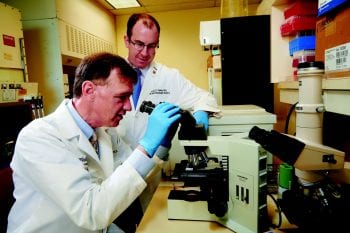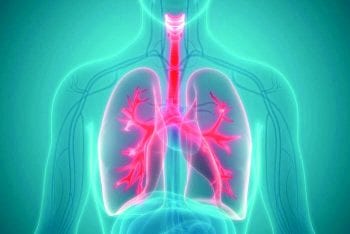Basic and Translational Research

The National Cancer Institute’s Human Tumor Access Network awarded researchers a grant to build tumor atlases that link the results of genomic and proteomic analyses with the cellular architecture of a tumor. Surgical oncologist Ryan Fields, MD, and Research Vice Chair William Gillanders, MD, will team with optical radiology researcher Sam Achilefu, PhD, and Li Ding, PhD, of the McDonnell Genome Institute, to study treatment response and resistance in breast and pancreatic cancer. The project reflects Washington University’s emphasis on the use of imaging and omics technologies to deeply characterize tumors at the molecular and microenvironment levels. The five-year project includes a longitudinal study of DNA, RNA and protein sequencing at tumor diagnosis, progression and metastasis.
Clinical research
Clinical research administrators are optimizing how Epic, the new BJC HealthCare-wide electronic health record system, is used to improve communications and transparency. Epic lets research coordinators know when patients are being treated and alerts clinical teams that patients are on a study drug or have an investigational device.
Major clinical studies include a new chemotherapy delivery technique for patients with ocular melanoma, a rare but deadly condition. A perfusion pump delivers chemotherapy directly to the liver, a common site of metastasis. Another study sends damaged donor lungs to an external facility for ex vivo perfusion; the site attempts to restore the organs and return suitable ones for transplant, thereby expanding the donor pool. Clinical researchers also have expanded transcatheter valve replacement trials in patients with early aortic valve disease and mitral valve disease.
Public health research
The division’s investigators from multiple disciplines collaborate with Department of Surgery and other medical school faculty on innovative projects that affect public health and clinical care. The division also offers a master of population health sciences degree that physicians, postgraduate trainees and medical students earn to broaden their knowledge of clinical effectiveness and other public health fields.
Division research offers true breadth in the public health sciences field: epidemiology, chronic disease prevention, cancer prevention, biostatistics, community-based participatory research, comparative effectiveness, health disparities, public health, cancer genetics, genomics, health literacy and communication, and health economics.
Highlights

Researchers at Washington University School of Medicine and Northwestern University Feinberg School of Medicine in Chicago have uncovered mechanisms that trigger primary graft dysfunction after lung transplantation, a leading cause of early graft failure that contributes to comparatively poor long-term outcomes. Washington University’s Daniel Kreisel, MD, PhD, and Northwestern University’s Ankit Bharat, MD, both surgical lung transplant directors at their institutions, and colleagues used an animal model to discover how inflammatory cells enter transplanted lungs. The study, published in the Journal of Clinical Investigation, is significant because lung transplant outcomes are significantly worse than for other organs: only about half of lung transplant patients are alive five years after surgery compared to about 70 to 80 percent for other organ transplants.
A team led by Matthew Wood, PhD, director of the Peripheral Nerve Research Laboratory, recently determined that T cells and Type 2 cytokines are necessary to promote nerve regeneration from the proximal nerve to the distal nerve. Many labs have attempted to design these nerve “bridges,” but efforts have proven largely ineffective to promote regeneration across long defects (>3cm). To advance this discovery, Wood received a grant from the McDonnell Center for Cellular and Molecular Neurobiology at Washington University. Plastic surgeon Alison Snyder-Warwick, MD, and researcher Anja Fuchs, PhD, are collaborators.
Plastic surgeon Amy Moore, MD, and military researchers in Bethesda, Md., are completing animal studies testing a technique to treat painful neuromas, nerve cells that regenerate at the end of a cut nerve after amputation. Moore also initiated another Department of Defense study, a human trial testing techniques to improve sensation — the ability to feel–after nerve injury.